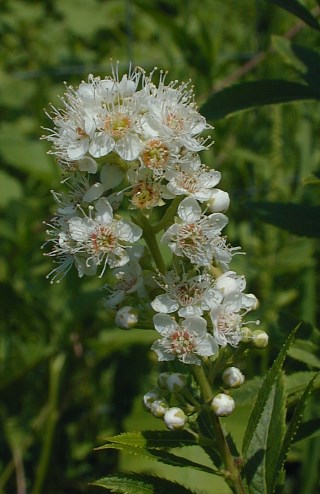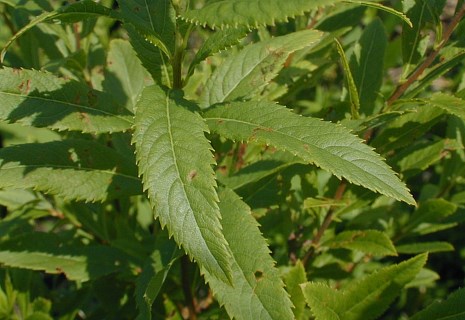Description:
This
shrub is 2-6' tall and sparingly branched. Young
branches are green and glabrous, but they become smooth, brown, and
woody with age. Alternate leaves (up to 3" long and ¾" across) occur
along the young branches of this shrub; they are densely distributed
along these branches. The leaves are narrowly ovate, sharply serrated, pinnately veined, and
glabrous (rarely sparsely hairy underneath); they have short petioles.
The upper side of each leaf is medium green, while its lower side is
pale green. The branches terminate in panicles of flowers about 2-6"
long; these panicles are oblongoid to pyramidal in shape. The stalks of
each panicle are light green and either glabrous or pubescent. Each
flower is about ¼" across, consisting of 5 white petals, 5 light green
sepals, 5 light green pistils, and numerous stamens (20 or more). The
petals are much longer than the sepals, while the filaments of the
stamens are much longer than the styles of the pistils. Where the
nectaries of each flower are located, there is a narrow ring-like
structure that surrounds the 5 pistils in the center of the flower;
this floral structure is pink, orange, or yellow. The blooming period
occurs from mid- to late summer and lasts about 1-2 months. Each flower
is replaced by a cluster of 5 hairless follicles with short beaks; each
follicle opens along one side to release its seeds (about 2-5 per
follicle). The leaves of this shrub are deciduous and its root system
is woody.
leaves are narrowly ovate, sharply serrated, pinnately veined, and
glabrous (rarely sparsely hairy underneath); they have short petioles.
The upper side of each leaf is medium green, while its lower side is
pale green. The branches terminate in panicles of flowers about 2-6"
long; these panicles are oblongoid to pyramidal in shape. The stalks of
each panicle are light green and either glabrous or pubescent. Each
flower is about ¼" across, consisting of 5 white petals, 5 light green
sepals, 5 light green pistils, and numerous stamens (20 or more). The
petals are much longer than the sepals, while the filaments of the
stamens are much longer than the styles of the pistils. Where the
nectaries of each flower are located, there is a narrow ring-like
structure that surrounds the 5 pistils in the center of the flower;
this floral structure is pink, orange, or yellow. The blooming period
occurs from mid- to late summer and lasts about 1-2 months. Each flower
is replaced by a cluster of 5 hairless follicles with short beaks; each
follicle opens along one side to release its seeds (about 2-5 per
follicle). The leaves of this shrub are deciduous and its root system
is woody.
Cultivation:
Meadowsweet prefers full sun, wet to moist conditions, and soil
containing abundant organic material (including peat). Standing water
is tolerated if it is temporary.
Range & Habitat:
The native Meadowsweet is occasional in northern Illinois, uncommon in
central
Illinois, and rare or absent in the southern section of the state (see Distribution
Map). It prefers glaciated areas of the state that are sunny
and poorly drained. Habitats include wet prairies, low areas along
streams, edges of marshes, bogs, and ditches.
Faunal Associations:
The flowers produce nectar and pollen; they attract honeybees,
bumblebees, Halictid bees, masked bees (Hylaeus spp.), Andrenid bees,
wasps, ants, Syrphid flies, small butterflies, long-horned beetles
(Cerambycidae), and other beetles (Krombein et al., 1979; Wilhelm
& Rericha, 2017; Small, 1976; Teull et al., 2008; Grundel et
al., 2011; Voss, 1954; Swengel & Swengel, 2000; Gosling, 1986).
The
caterpillars of the butterfly,
Celastrina ladon
(Spring Azure), feed destructively on the flowers and buds of Meadowsweet (Spiraea
alba), while a leaf beetle, Tricholochmaea
spiraeae,
is a specialist feeder on this plant. Other insects that feed
destructively on various parts
of this plant include larvae of gall flies, plant bugs, aphids, armored
scales, larvae of Tortrix moths, and larvae of other moths (see the
Insect Table for a more complete list of these species). Among
vertebrate animals, the
Ruffed Grouse and Greater Prairie Chicken feed on leaves, buds, and
seeds of
Meadowsweet. White-Tailed Deer often browse on the leaves and twigs,
while the Muskrat feeds on the woody stems and shoots to a minor extent
(DeGraaf, 2002; Martin et al., 1951/1961; Hamerstrom & Blake,
1939; personal observations). In addition to these, observations, such
songbirds and gamebirds as the Indigo Bunting, Grasshopper Sparrow,
Song Sparrow, Red-winged Blackbird, American Woodcock, and Wild Turkey
use Meadowsweet as protective cover and/or
nesting sites (DeGraaf, 2002). See the Bird Table for a more complete
list of these species.

Photographic
Location:
A seasonal wetland at Judge Webber Park in Urbana, Illinois.
Comments:
This is one of two native Spiraea spp. in Illinois.
The other species, Spiraea tomentosa (Steeplebush),
is a more hairy shrub with pink flowers. In Illinois, it is less common
than Meadowsweet and it prefers sandy wetlands. Another species, Spiraea
latifolia (Eastern Meadowsweet), is found in wetlands further
to the east. This species is very similar in appearance to Spiraea
alba (Meadowsweet), except it has leaves that are more broad.
Sometimes Eastern Meadowsweet is considered a variety of Meadowsweet
and it is referred to as Spiraea alba latifolia. The
showy Spiraea spp. that are commonly cultivated as
landscape plants have been introduced from the Old World. They rarely
escape from cultivation and are not often found in natural habitats.